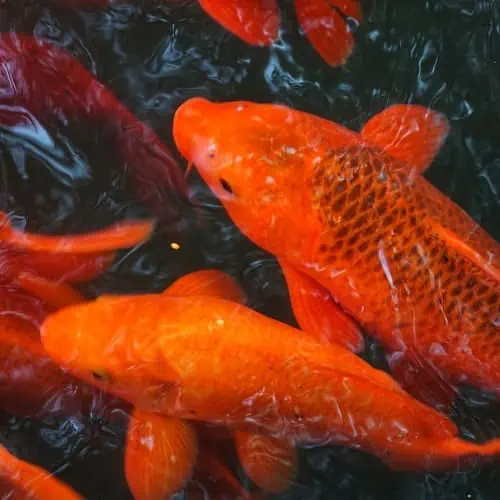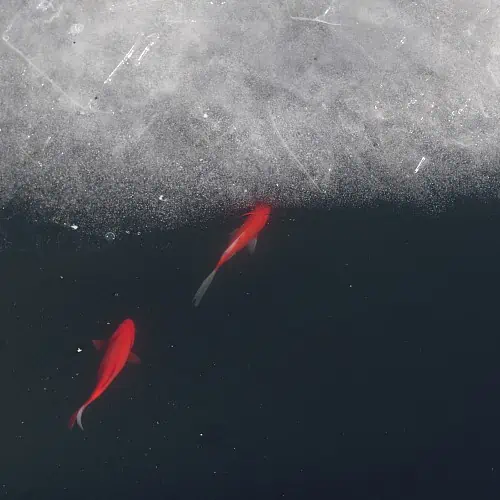When Do I Feed Koi Fish
How Often & How Much Should I Feed My Koi? (Koi Feeding Chart)

Koi are poikilothermic (cold-blooded) organisms, which means they are unable to regulate their own internal body temperatures. As water temperatures fluctuate throughout the year, so do the rates of many of their bodily functions. Their metabolic rates are particularly sensitive and will hasten or slow down depending on ambient conditions.
The warmer the water, the more active koi become. Their metabolic functions are optimized at temperatures above 70˚F (21˚C). As they expend more energy, they will require more frequent feeding times and higher-quality protein-rich food. Conversely, as temperatures drop in the winter, they enter a conservative state that will diminish their metabolic rates significantly. This dependence on temperature for metabolic functions is a typical feature of many fish species native to temperate zones. It allows them to effectively allocate energy stores through the seasons.
To ensure that the frequency with which you feed your koi is appropriate, carefully monitor your pond's water temperature. It is also important to observe your koi's activity levels, as this will help you determine the feeding range that is best for your pond. Keep in mind that overfeeding can compromise the quality of your pond water and reduce the efficiency of your filtration system, aside from potentially causing digestive issues. Thus, it is always better to underfeed than to overfeed. Refer to the table below for recommendations on feeding frequency and feed types for koi.
| Water Temperature | Feeding Frequency | Feed Type |
| Below 40˚F (4.5˚C) | Do not feed | None |
| 41 – 50˚F (5 – 10˚C) | Feed no more than 1 – 2 times/week | Wheat Germ-based food |
| 50 – 55˚F (10.5 – 13˚C) | Feed 2 – 3 times/week | |
| 56 – 60˚F (13.5 – 15.5˚C) | Feed 3 – 4 times/week | |
| 61 – 65 ˚F (16 – 18.5˚C) | Feed 4 – 5 times/week | Wheat Germ + Protein-based food |
| 66 – 70 ˚F (19 – 21˚C) | Feed 1 – 2 times/day | Aquatic Protein-based food + Wheat Germ |
| 71 – 75 ˚F (22 – 24˚C) | Feed 2 – 4 times/day | Aquatic Protein-based food (Growth Diets) with optional color enhancers |
| 76 – 80 ˚F (24.5 – 27˚C) | Feed 2 – 3 times/day | |
| 81 – 85 ˚F (27 – 29.5˚C) | Feed 1x every other day | Aquatic Protein-based food |
| Above 85 ˚F (30˚C) | Reduce feeding | Wheat-germ/None |
How Much Should I Feed My Koi?

When deciding how much food to give your koi, remember that a good target amount is 1 – 4% of their body weight. Mature koi will generally eat less relative to their body weight than juvenile koi, which are also less sensitive to water temperatures and can tolerate more frequent feedings.
As a rule of thumb, try to feed just enough for your koi to consume within 3 – 5 minutes at any given time. If a considerable amount of fish feed remains after the 5-minute mark, you will have to reduce how much food you provide in the next feeding session. Make sure to remove uneaten food after 20 minutes or before they sink to the bottom, as this can affect your pond's water quality.
There's a lot of trial and error involved in getting the feeding frequency and feed amounts right. With a little bit of patience and observation, you'll surely find a balance between both! Simply remember that it pays to be more conservative rather than excessive when it comes to feeding koi.
Won't Koi Go Hungry in the Winter?

As temperatures drop to below 5˚C (40˚F) in winter, your koi will naturally enter a state of energy conservation, called torpor. This is essentially a minor form of hibernation in which their bodily functions are slowed down drastically – enough to allow them to survive with little or no food. Their bodies' biochemical reactions, particularly those involved in metabolism, are greatly reduced as a pond freezes over. This occurs as digestive enzymes and bacteria become absent or grow dormant, preventing any available food from being properly digested.
Although you may see your koi swimming along the pond bottom at this time, it would be best to withhold feeding completely. Any feed consumed at this time may be more harmful than beneficial, as the uneaten food would simply contribute to excess waste in the pond and could lead to rising ammonia and nitrate levels come spring.
Feeding Koi in Spring

When the final frosts thaw in early spring and water temperatures begin to rise once more, you will understandably grow eager to feed your fish! Prior to the first feeding session of the year, make sure to check your pond's water parameters. Ideally, water temperatures should rise to at least 9 – 10˚C, restarting your fish's metabolic functions. Before feeding, make sure the pond's filtration system and pump are functional so that fish waste that accumulated over winter can be broken down.
Once your pond is fully functional, you may begin to feed your koi. Start by providing easily digestible food (a wheat germ-based feed is a popular choice) 1 – 2 times a week. You will need to carefully monitor your koi's activity levels and behavior to determine when they would best benefit from having food. Do try to feed them during the warmest part of the day, between 10 am to 2 pm, or when the temperature is most stable. If you find that your koi do not readily eat, avoid excessive feeding and remove unconsumed fish feed.
You can gradually increase the feeding frequency to up to 2x a day while paying close attention to rising water temperatures. To boost your koi's immune system, you can supplement their diets with vitamin-rich treats, such as orange halves, grapefruit slices, romaine lettuce, and squash. Keep in mind that temperatures below 18˚C (64˚F) may still prevent them from effectively digesting proteins. Carbohydrates may be a more important source of energy for them at this time.
Feeding Koi in Summer

Your koi will increasingly grow active as temperatures rise. Their energy needs peak during the summer months, during which temperatures above 21˚C (70˚F) boost their metabolism considerably. At this time, they should be fed protein-rich food (growth diets) 2 – 4 times a day, depending on their activity level. Though they may be eager to consume large amounts of food per feeding session, it would be best to feed smaller portions at a higher frequency. This prevents overeating and ensures that no food goes to waste.
During the hottest summer weeks, try to restrict feeding times to when water temperatures are cooler. Ideally, you should provide them with food earlier in the morning and later in the afternoon. When temperatures are too high (i.e. above 30˚C/85˚F), koi can completely lose their appetite. If this occurs, reduce the feeding frequency and stick to easily digestible fish feeds. You may also try to lower water temperatures by providing shade or shelter in the form of aquatic plants.
Feeding Koi in Fall

As temperatures begin to drop once more, the activity levels of your koi community will increasingly decrease. You might observe that your fish swim more slowly or closer to the bottom of your pond. They may also lose interest in food, indicating that their metabolism has slowed down. As temperatures dip to below 18˚C (65˚F), gradually reduce the feeding frequency to 4 – 5 times/week. You can also increase the ratio of wheat germ in your fish's diet, as the reduced metabolism will prevent them from making the most of more expensive higher-protein based feeds.
Fall is an important time to pay close attention to decreasing water temperatures. As winter nears and temperatures drop to less than 12˚C (54˚F), feed your koi no more than 1 – 2 times a week. Make sure the feeding sessions take place when the water is warmest, perhaps mid to late afternoon. At this point, your koi should only be consuming wheat-germ-based diets. Stop feeding them altogether when pond water temperatures are less than 10˚C (50˚F).
Source: https://pondinformer.com/koi-feeding-guide/
Belum ada Komentar untuk "When Do I Feed Koi Fish"
Posting Komentar